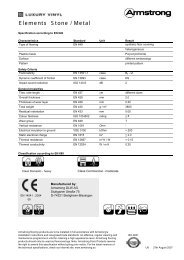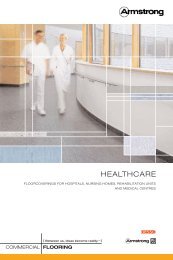to download Anker "a gallery of modernity" catalogue.
to download Anker "a gallery of modernity" catalogue.
to download Anker "a gallery of modernity" catalogue.
You also want an ePaper? Increase the reach of your titles
YUMPU automatically turns print PDFs into web optimized ePapers that Google loves.
A Gallery <strong>of</strong> Modernity<br />
ANKER-Teppichboden<br />
Gebr. Schoeller GmbH + Co. KG<br />
Postfach 10 19 26 | D - 52319 Düren<br />
Phone +49 (0) 24 21/804-0<br />
Telefax +49 (0) 24 21/804-200<br />
Export<br />
Phone + 49 24 21/804-216<br />
Fax + 49 24 21/804-309<br />
anker@anker-dueren.de<br />
www.anker-teppichboden.de
A GALLERY OF MODERNITY<br />
ANKER-TEPPICHBODEN has been producing textile floor coverings for over<br />
150 years. During that same span <strong>of</strong> time, architecture liberated itself from<br />
its neo-his<strong>to</strong>rical bonds and has since arrived in the present via Arts &<br />
Crafts, Modernism and post-war Modernism. ANKER-TEPPICHBODEN has<br />
accompanied this process from the outset. We have worked consistently<br />
with leading architects and interior designers during all <strong>of</strong> these eras –<br />
welcoming the inspiration and challenges they have <strong>of</strong>fered. This small<br />
brochure traces our progress through 150 years <strong>of</strong> architectural his<strong>to</strong>ry.<br />
Thus it is no coincidence that ANKER-TEPPICHBODEN has been the leading<br />
German producer <strong>of</strong> commercial-grade carpeting for decades. Our collaboration<br />
with all <strong>of</strong> these architects and interior designers has involved us in<br />
a continuous learning process that has shaped the philosophy <strong>of</strong> our company.<br />
The challenges posed by such architects as Ludwig Mies van der Rohe,<br />
Egon Eiermann, Lord Norman Foster and Andrée Putman in the past and<br />
the present have ensured the progressive development and optimization <strong>of</strong><br />
our products.<br />
We realized early on that carpets for pr<strong>of</strong>essional use in buildings <strong>of</strong> high<br />
architectural quality are more than short-lived trend products. Thus we<br />
have always regarded our commercial carpets as technical systems. And<br />
architects consistently challenge us <strong>to</strong> come up with new and innovative<br />
design and material solutions.<br />
We strive <strong>to</strong> ensure that the colours, structures and surfaces <strong>of</strong> our carpeting<br />
are always in tune with contemporary developments in architecture. The<br />
technical design, material characteristics and performance features <strong>of</strong> our<br />
carpeting are oriented <strong>to</strong>ward the requirements that must be met by modern<br />
<strong>of</strong>fice buildings, hotels, health-care and nursing facilities or shopping malls.<br />
Over 150 years <strong>of</strong> architecture and more than 150 years <strong>of</strong> ANKER-TEPPICH-<br />
BODEN have combined <strong>to</strong> produce an “ANKER Gallery <strong>of</strong> Modernity”, from<br />
which we are pleased <strong>to</strong> present a small selection <strong>of</strong> highlights in this brochure.
Charles rennie Mackin<strong>to</strong>sh<br />
Bauhaus-Architects<br />
ludwig Mies van der Rohe<br />
Egon Eiermann<br />
Ralf Schüler<br />
Frank O. Gehry & Thomas Beucker<br />
Lord Norman Foster<br />
AndrÉe Putman<br />
ANKER-TEPPICHBODEN AND PRE-MODERN ARCHITECTURE<br />
The Scottish architect Charles Rennie Mackin<strong>to</strong>sh marks the transition <strong>to</strong><br />
the modern era in architecture and design. In his “Arts Lovers House” in<br />
Glasgow, he blended architecture, interior design and product design <strong>to</strong><br />
create an appealing <strong>to</strong>tal work <strong>of</strong> art. All elements in the house were designed<br />
in keeping with a uniform concept – and executed with equal rigour<br />
and consistency.<br />
During those years, designers at <strong>Anker</strong>-TEPPICHBODEN responded in their<br />
own designs not only <strong>to</strong> the work <strong>of</strong> such architects as Mackin<strong>to</strong>sh – but also<br />
<strong>to</strong> the leading designers <strong>of</strong> the Art Deco, Art Nouveau and Arts and Crafts<br />
movements.<br />
Pho<strong>to</strong>: The Annan Gallery
Charles rennie Mackin<strong>to</strong>sh<br />
Bauhaus-Architects<br />
ludwig Mies van der Rohe<br />
Egon Eiermann<br />
Ralf Schüler<br />
Frank O. Gehry & Thomas Beucker<br />
Lord Norman Foster<br />
AndrÉe Putman<br />
ANKER-TEPPICHBODEN AND EARLY MODERN ARCHITECTURE<br />
Product designs by the Bauhaus architects consistently reflected the possibilities<br />
<strong>of</strong>fered by current developments in technology. The robust yet lightweight<br />
tubular steel furniture designed by Marcel Breuer signalled the beginning<br />
<strong>of</strong> the modern era in the field <strong>of</strong> product design as well. High-performance<br />
materials were commonly used in state-<strong>of</strong>-the-art technology, as is evident<br />
in the pho<strong>to</strong>graphs <strong>of</strong> passenger cabins in German aircraft. In order <strong>to</strong> reduce<br />
weight <strong>to</strong> a minimum while meeting the highest standards <strong>of</strong> comfort, tubular<br />
aluminium pr<strong>of</strong>iles were <strong>of</strong>ten used in furniture construction.<br />
The same requirements applied <strong>to</strong> floor coverings in dirigibles. And thus<br />
<strong>Anker</strong> carpeting was selected – in a design developed by Pr<strong>of</strong>. Soeder,<br />
the chief architect at the Zeppelin Works.<br />
Pho<strong>to</strong>: Bauhaus-Archive Berlin, Lucia Moholy
Charles rennie Mackin<strong>to</strong>sh<br />
Bauhaus-Architects<br />
ludwig Mies van der Rohe<br />
Egon Eiermann<br />
Ralf Schüler<br />
Frank O. Gehry & Thomas Beucker<br />
Lord Norman Foster<br />
AndrÉe Putman<br />
ANKER-TEPPICHBODEN AND CLASSICAL MODERN ARCHITECTURE<br />
One <strong>of</strong> the crowning achievements <strong>of</strong> the modern architecture in Germany<br />
during the 1950s was the National Gallery in Berlin. This mature late work<br />
by Ludwig Mies van der Rohe remains a symbol <strong>of</strong> the beginning <strong>of</strong> a new<br />
era <strong>of</strong> architecture in Germany – and <strong>of</strong> a new chapter in the his<strong>to</strong>ry <strong>of</strong><br />
classical modernism. The building is a symbol <strong>of</strong> an indivisible Germany<br />
in a divided city.<br />
Mies van der Rohe selected ANKER carpeting for the floors <strong>of</strong> the National<br />
Gallery – in a design he developed specifically for that project. The carpets<br />
were first replaced in 1988 and again in 2004 – in each case after nearly<br />
twenty years <strong>of</strong> use, and in each case with ANKER carpeting based on the<br />
original design.<br />
Pho<strong>to</strong>: Bauhaus-Archive Berlin
Charles rennie Mackin<strong>to</strong>sh<br />
Bauhaus-Architects<br />
ludwig Mies van der Rohe<br />
Egon Eiermann<br />
Ralf Schüler<br />
Frank O. Gehry & Thomas Beucker<br />
Lord Norman Foster<br />
AndrÉe Putman<br />
ANKER-TEPPICHBODEN and post-war modernism<br />
The second phase <strong>of</strong> the modern era in Germany began with the buildings designed<br />
by Egon Eiermann. It was no longer the old Bauhaus teachers who now<br />
set about <strong>to</strong> shape the image <strong>of</strong> the Federal Republic <strong>of</strong> Germany but rather<br />
a new generation <strong>of</strong> architects. Egon Eiermann’s high-rise <strong>of</strong>fice building for<br />
delegates <strong>to</strong> the German Bundestag – also known as the “Langer Eugen” –<br />
and the German pavilion at the World’s Fair in Brussels were two <strong>of</strong> the most<br />
striking German buildings erected during this period.<br />
And the carpeting in both Bonn and Brussels was designed in cooperation with<br />
<strong>Anker</strong>-TEPPICHBODEN. The carpeting for the pavilion in Brussels featured<br />
a design developed by Pr<strong>of</strong>. Margret Hildebrand, the interior designer responsible<br />
for the project.<br />
Pho<strong>to</strong>: Work archives Egon Eiermann
Charles rennie Mackin<strong>to</strong>sh<br />
Bauhaus-Architects<br />
ludwig Mies van der Rohe<br />
Egon Eiermann<br />
Ralf Schüler<br />
Frank O. Gehry & Thomas Beucker<br />
Lord Norman Foster<br />
AndrÉe Putman<br />
ANKER-TEPPICHBODEN AND THE LATE MODERN ERA<br />
The buildings that originated in the early 1970s reflect a mood <strong>of</strong> boundless<br />
optimism and belief in a bright future made possible by technology. The International<br />
Conference Centre (ICC) in Berlin stands as a symbol <strong>of</strong> this faith<br />
in progress. Designed by Berlin architect Ralf Schüler, the ICC represented<br />
an optimistic landmark <strong>of</strong> a high-tech society within the urban organism <strong>of</strong><br />
Berlin, a gateway <strong>to</strong> the western part <strong>of</strong> the city.<br />
The <strong>Anker</strong> carpeting he selected for the project represents the Op Art <strong>of</strong><br />
the period and complements the overall architectural concept <strong>of</strong> the ICC.<br />
Pho<strong>to</strong> privately: Ralf Schüler
Charles rennie Mackin<strong>to</strong>sh<br />
Bauhaus-Architects<br />
ludwig Mies van der Rohe<br />
Egon Eiermann<br />
Ralf Schüler<br />
Frank O. Gehry & Thomas Beucker<br />
Lord Norman Foster<br />
AndrÉe Putman<br />
ANKER-TEPPICHBODEN AND CONTEMPORARY ARCHITECTURE<br />
The buildings designed by Frank O. Gehry played an instrumental role in<br />
res<strong>to</strong>ring architecture <strong>to</strong> its rightful place as a focus <strong>of</strong> broad public interest.<br />
The Zollh<strong>of</strong> project in Düsseldorf evolved in<strong>to</strong> an icon <strong>of</strong> contemporary architecture.<br />
Aside from the striking design <strong>of</strong> the trio <strong>of</strong> buildings, a major challenge<br />
posed by this project was the highly complex realization phase carried<br />
out under the supervision <strong>of</strong> Thomas Beucker <strong>of</strong> the German firm <strong>of</strong> Beucker,<br />
Maschlanka & Partner.<br />
An integral component <strong>of</strong> the sophisticated concept is the <strong>Anker</strong> carpeting<br />
installed in the Zollh<strong>of</strong>.<br />
Pho<strong>to</strong>: Thomas Mayer Archive
Charles rennie Mackin<strong>to</strong>sh<br />
Bauhaus-Architects<br />
ludwig Mies van der Rohe<br />
Egon Eiermann<br />
Ralf Schüler<br />
Frank O. Gehry & Thomas Beucker<br />
Lord Norman Foster<br />
AndrÉe Putman<br />
ANKER-TEPPICHBODEN AND CONTEMPORARY ARCHITECTURE<br />
Lord Norman Foster is regarded world-wide as one <strong>of</strong> the most important<br />
architects <strong>of</strong> the past several decades. He is a rigorous advocate <strong>of</strong> innovation,<br />
and the challenges he poses <strong>to</strong> project engineers and companies have<br />
regularly triggered new developments in building technology. His projectbased<br />
and independent contributions <strong>to</strong> product design have earned him<br />
a reputation as the most influential designer in this field. One <strong>of</strong> his most<br />
recent projects was the Freie Universität in Berlin.<br />
The new carpeting solution developed in collaboration with <strong>Anker</strong>-Teppich-<br />
BODEN represents the finishing <strong>to</strong>uch that brings the interior design concept<br />
for the Berlin project <strong>to</strong> successful completion.<br />
Pho<strong>to</strong>: Carolyn Djanogly
Charles rennie Mackin<strong>to</strong>sh<br />
Bauhaus-Architects<br />
ludwig Mies van der Rohe<br />
Egon Eiermann<br />
Ralf Schüler<br />
Frank O. Gehry & Thomas Beucker<br />
Lord Norman Foster<br />
AndrÉe Putman<br />
ANKER-TEPPICHBODEN AND CONTEMPORARY ARCHITECTURE<br />
Andrée Putman is the grande dame <strong>of</strong> international interior design. The<br />
crea<strong>to</strong>r <strong>of</strong> interiors <strong>of</strong> timeless quality, she has remained independent <strong>of</strong><br />
short-lived current and fashionable trends for fifty years. In her projects,<br />
she unites the highest standards <strong>of</strong> design with the consistent use <strong>of</strong> the<br />
very best materials available.<br />
Andrée Putman designs carpets world-wide for well-known buildings, for<br />
example – <strong>to</strong>gether with the product designers <strong>of</strong> ANKER-TEPPICHBODEN<br />
– modular carpet tiles laid in a random design, all in the same direction.<br />
Pho<strong>to</strong>: Brigitte Baudesson








